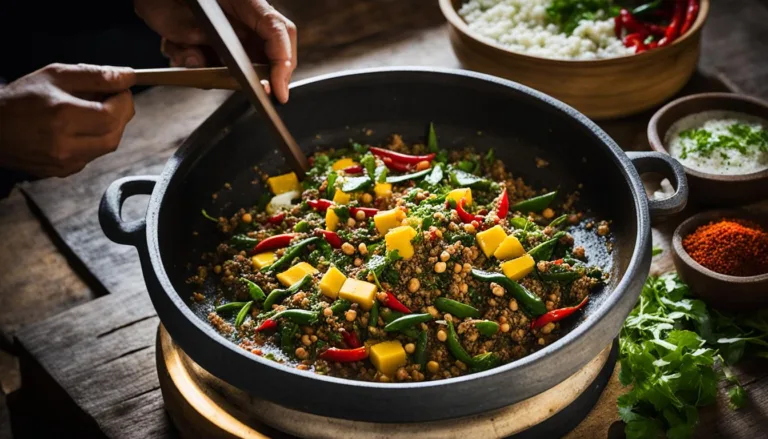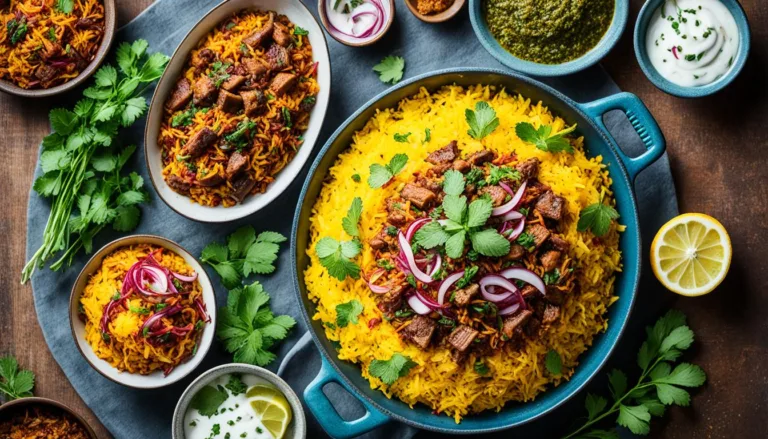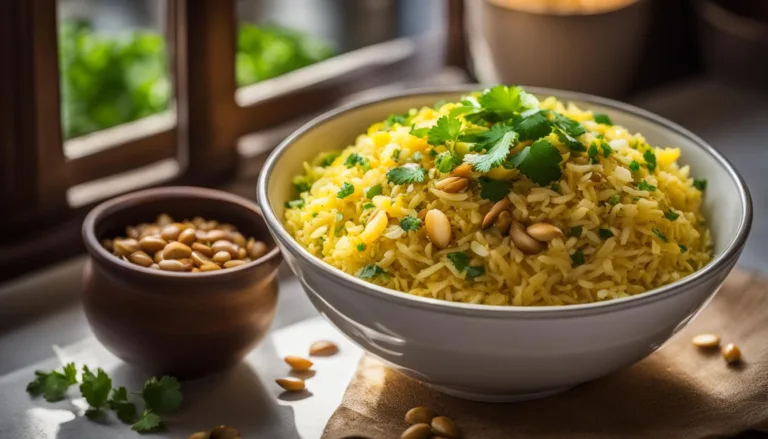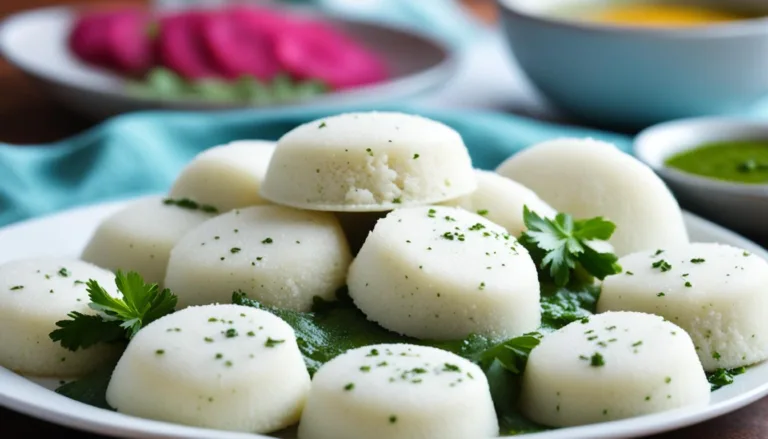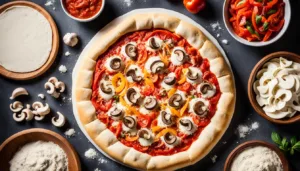Welcome to our easy dosa recipe guide! If you’ve always wanted to try making dosa at home but felt intimidated by the process, this recipe is perfect for you. We’ve simplified the steps so that even beginners can create a delicious and crispy dosa from scratch. Say goodbye to store-bought mixes and impress your family and friends with your homemade dosa making skills!
Dosa is a beloved South Indian dish that has gained popularity worldwide. It is a thin and crispy crepe made from fermented rice and lentil batter. With our easy dosa recipe, you’ll be able to recreate this authentic South Indian favorite in your own kitchen.
From understanding the essential ingredients to mastering the art of spreading dosas and cooking them to perfection, we will guide you through every step of the process. You’ll learn how to create the perfect dosa batter, achieve the ideal consistency, and cook dosas that are golden brown and crispy.
Not only will you learn the traditional plain dosa recipe, but we’ll also show you how to make a delicious masala dosa filled with spiced potatoes. Along the way, we’ll explore different variations and serving suggestions to add variety to your dosa repertoire.
So why wait? Let’s get started on your dosa-making journey and enjoy the authentic taste of this popular South Indian dish right at home. The aroma of the dosas cooking on the griddle and the satisfaction of creating these delicious pancakes from scratch will make every bite worth it!
Table of Contents
Key Takeaways:
- Our easy dosa recipe is perfect for beginners looking to make dosa at home.
- Dosa is a popular South Indian dish made from fermented rice and lentil batter.
- We will guide you through the process of creating the perfect dosa batter and cooking dosas to perfection.
- Learn how to make traditional plain dosa as well as delicious masala dosa with spiced potatoes.
- Explore different variations and serving suggestions to add variety to your dosa experience.
Introducing the South Indian Favorite: Dosa
Dosa is a beloved South Indian dish that has gained popularity worldwide. It is a thin and crispy crepe made from fermented rice and lentil batter. Dosa is typically served with chutney and sambar, and it can be enjoyed for breakfast, lunch, or dinner.

Discover the rich history and cultural significance of dosa as you embark on your journey to make this delicious dish at home. With our authentic dosa recipe, you’ll be able to recreate the flavors of South India and enjoy a crispy dosa that will tantalize your taste buds.
Understanding the Essential Ingredients for Your Dosa Homemade
The key to making the perfect dosa lies in using the right ingredients. In this section, we will explore the essential components that go into creating a delicious and authentic homemade dosa.
Choosing the Right Rice
When it comes to dosa, the type of rice you use plays a crucial role in determining the texture and taste of the final dish. Traditionally, a variety of rice called “dosa rice” or “idli rice” is used, as it has a higher starch content and lends a distinct flavor to the dosa. However, if you cannot find dosa rice, you can also use regular raw rice or parboiled rice. Just ensure that the rice you choose is of good quality and suitable for dosa-making.
The Role of Urad Dal in Your Dosa
Urad dal, also known as black gram lentils, is another essential ingredient in dosa batter. It not only adds a rich, creamy texture to the batter but also aids in the fermentation process. Urad dal provides the necessary proteins and enzymes that help the batter ferment and develop the characteristic tangy flavor of dosa. It is important to use whole urad dal and not split urad dal for best results.
To better understand the importance of these dosa ingredients, take a look at the visual guide below:

Comparison of Dosa Rice Types
| Dosa Rice Type | Characteristics | Availability |
|---|---|---|
| Dosa Rice/Idli Rice | Higher starch content, distinct flavor | Available in Indian grocery stores |
| Raw Rice | Widely available, milder taste | Available in most grocery stores |
| Parboiled Rice | Partially boiled, grains are firmer | Available in most grocery stores |
With a good understanding of the dosa ingredients, you are well-equipped to create a delicious homemade dosa. In the next section, we will delve into the process of creating the perfect dosa batter recipe.
The Perfect Blend: Creating Your Dosa Batter Recipe
Mastering the art of creating the perfect dosa starts with the batter. Follow our step-by-step recipe to ensure your dosa batter is well-prepared and ready to cook.
Soaking the Ingredients
Begin by soaking the rice and urad dal in water for at least 4-6 hours, or overnight. This process is crucial as it helps soften the grains and make them easier to grind. Rinse the soaked ingredients thoroughly before grinding to remove any impurities.
Grinding the Batter
Grind the soaked rice and urad dal separately using a wet grinder or blender. Add water intermittently to achieve a smooth and thick consistency. The grinding process may take some time, but it’s essential for achieving the desired texture of the dosa batter. Aim for a batter that is neither too thick nor too runny.

Fermentation Tips for the Best Results
Once the batter is well-ground, transfer it to a large bowl or container. Cover the container with a clean cloth or plastic wrap and let it ferment for 8-12 hours, or overnight, in a warm place. Fermentation is a crucial step as it helps develop the unique flavor and texture of dosa.
During fermentation, the batter will rise and double in volume. It should have a slightly sour aroma and a bubbly texture. If your kitchen is colder, you can place the batter in an oven with the pilot light on or use a fermentation box to maintain the ideal temperature.
After fermentation, give the batter a gentle mix to combine any separated liquids. Your dosa batter is now ready to be transformed into crispy and flavorful dosas.
Mastering the Art of Spreading Dosas
When it comes to creating the perfect dosa, spreading the batter evenly on the griddle is crucial. This technique ensures that your dosa becomes thin, crispy, and delicious. But how do you achieve that even, smooth spread?
Here are some tips to master the art of spreading dosas:
- Preheat the griddle: Begin by preheating your griddle on medium heat. This will help the batter spread evenly.
- Use the right amount of batter: Take a ladleful of dosa batter and pour it in the center of the griddle.
- Spread in circular motions: Using the back of the ladle or a flat-bottomed cup, gently spread the batter in circular motions from the center towards the edges of the griddle. Keep rotating your wrist to create a thin and even layer.
- Avoid gaps: Ensure that there are no gaps or holes in the dosa by filling them with a little extra batter.
- Achieve the perfect thickness: To achieve the desired thickness, spread the batter thinly for a crispy dosa or leave it slightly thicker for a softer dosa.
- Practice makes perfect: Spreading dosas takes practice, so don’t be discouraged if your first attempts are not perfect. With time, you’ll develop the right technique and be able to spread dosas like a pro.

With these tips and a little practice, you’ll be able to create beautiful dosas that are both visually appealing and delicious. So, roll up your sleeves, grab your ladle, and start spreading dosas with confidence!
Cooking Techniques for Crispy Dosa Recipe
When it comes to cooking dosa, attention to detail and proper techniques are key to achieving a crispy and perfectly cooked outcome. In this section, we will explore two important aspects of cooking dosa: temperature and timing, and the right cookware to use.
Temperature and Timing
The right temperature is crucial for cooking dosas to perfection. Too low, and your dosa will turn out soggy; too high, and it will burn. The ideal temperature for cooking dosas is medium-high heat. This allows the batter to cook gradually, ensuring a crispy texture and even browning.
Timing also plays a vital role in cooking dosas. It takes practice to determine the right amount of time needed to cook each side of the dosa. Generally, it should take around 2-3 minutes for the first side and 1-2 minutes for the second side. Keep an eye on the color and texture of the dosa to gauge when it’s ready to be flipped.
Using the Right Cookware
The type of cookware you use can greatly affect the outcome of your dosa. For crispy and evenly cooked dosas, it is recommended to use a non-stick flat skillet or a cast-iron griddle. These types of cookware distribute heat evenly, ensuring that the dosa cooks uniformly and doesn’t stick to the pan.
When cooking dosas, it is essential to use a flat ladle or spatula to spread the batter evenly on the pan. A curved spatula may result in uneven thickness and shape. Additionally, make sure to use a wide and shallow pan to allow for easy flipping of the dosa without breaking it.
Now that we’ve covered the importance of temperature and timing, as well as the right cookware to use, you’re ready to create delicious and crispy dosas. Follow these cooking techniques to ensure that your dosas turn out golden brown and irresistible.
Exploring Different Variations with Your Homemade Dosa Recipe
Get creative with your dosa-making by exploring different variations of this classic dish. Adding a twist to your homemade dosa recipe allows you to customize the flavors and create unique dosa experiences. Two popular variations of dosa that you can try are the Classic Plain Dosa and the Masala Dosa with Spiced Potatoes.
Classic Plain Dosa
The Classic Plain Dosa is a simple yet delicious variation that highlights the flavor of the fermented rice and lentil batter. It is a crispy and golden dosa that can be enjoyed on its own or paired with coconut chutney and sambar. The secret to making a perfect plain dosa lies in achieving a thin and evenly spread batter on the griddle.

Masala Dosa with Spiced Potatoes
For a more indulgent dosa experience, try the Masala Dosa with Spiced Potatoes. This variation features a filling of spiced mashed potatoes wrapped in a crispy dosa. The aromatic blend of spices and the creamy texture of the potatoes complement the crispy exterior of the dosa beautifully. Serve it with coconut chutney, sambar, and a side of tomato or onion chutney for a complete meal.
| Variation | Description | Serving Suggestion |
|---|---|---|
| Classic Plain Dosa | A crispy dosa made with fermented rice and lentil batter | Pair with coconut chutney and sambar |
| Masala Dosa with Spiced Potatoes | A dosa filled with spiced mashed potatoes | Serve with coconut chutney, sambar, and chutneys of your choice |
Dosa from Scratch vs. Store-bought Ready Mixes
When it comes to making dosa, you have two options: creating it from scratch or using store-bought ready mixes. Each method has its own advantages and considerations to keep in mind. Let’s take a closer look at both options to help you make an informed decision.
Homemade Dosa:
- Control over ingredients: Making dosa from scratch allows you to have full control over the ingredients used. You can choose high-quality rice and lentils, ensuring that your dosa is prepared with the freshest and most nutritious ingredients.
- Customizable flavor: Homemade dosa provides the opportunity to customize the flavor according to your taste preferences. You can experiment with different ratios of rice and lentils, as well as add spices and herbs to enhance the taste.
Dosa Mixes:
- Convenience: Dosa mixes offer a convenient alternative, especially for those with busy schedules. They come pre-packaged with the necessary ingredients, saving you time and effort in measuring and grinding.
- Potential trade-offs: While dosa mixes are convenient, they may not deliver the same authentic taste and texture as homemade dosas. The flavor and quality of the mixes can vary, and some may contain preservatives or additives.
Ultimately, the choice between homemade dosa and store-bought ready mixes depends on your priorities and preferences. If you value full control over ingredients and the ability to customize flavors, making dosa from scratch is the way to go. On the other hand, if convenience is a top priority, dosa mixes can be a time-saving option. Consider your needs and decide which method aligns best with your dosa-making goals.
Serving Suggestions: Complementing Your Dosa Pancake Recipe
Enhance the flavors of your homemade dosa with a variety of delicious accompaniments. To truly elevate your dosa experience, we recommend serving it with traditional coconut chutney and sambar. These classic pairings perfectly complement the taste and texture of dosa, adding a burst of flavor to every bite.
To make the coconut chutney, blend fresh grated coconut, roasted chana dal, green chilies, ginger, and a dash of lemon juice in a mixer. Season with salt and temper with mustard seeds, urad dal, curry leaves, and dried red chilies in hot oil. This creamy and tangy coconut chutney is the perfect accompaniment for your dosas.
Sambar, a flavorful and tangy lentil stew, is another must-have accompaniment for dosa. To make sambar, cook pigeon peas (toor dal), tamarind pulp, and a medley of vegetables such as onions, tomatoes, drumsticks, carrots, and eggplant in a fragrant blend of spices. Finish off the dish with a tempering of mustard seeds, asafoetida, curry leaves, and dried red chilies. The rich and aromatic sambar complements the dosas perfectly, adding a flavorful contrast to every bite.
If you’re feeling adventurous, you can also explore non-traditional accompaniments for your dosas. Experiment with different types of chutneys, such as mint chutney, tomato chutney, or peanut chutney. You can even try pairing your dosas with tangy tomato salsa or spicy cilantro sauce for a fusion twist.
The possibilities are endless when it comes to serving dosas. Let your creativity run wild and discover unique combinations that suit your palate. The key is to find accompaniments that balance the flavors of dosa and enhance your dining experience.
Storing and Reheating Tips for Your Indian Crepe Recipe
When it comes to enjoying dosas, it’s not always possible to devour them all at once. That’s why we’re here to share some valuable tips on how to store and reheat your leftover dosas. With these practices, you can ensure that your dosas maintain their texture and flavor, so you can savor them later without compromising on taste and quality.
Storing Dosas:
- Allow the dosas to cool completely before storing them. This helps prevent them from becoming soggy.
- Place the dosas in an airtight container or wrap them in aluminum foil, ensuring they are tightly sealed to maintain freshness.
- Store the dosas in the refrigerator to extend their shelf life. They can typically be stored for up to 2-3 days.
Reheating Dosas:
- Heat a non-stick pan or tawa over medium heat.
- Place the dosas on the heated pan and cook for a few minutes on each side until they become warm and crispy.
- You can also reheat dosas in a microwave by placing them on a microwave-safe plate and heating them for 30 seconds to 1 minute, or until they are warm.
Now that you know how to store and reheat your dosas, you can enjoy them whenever you crave that fresh-out-of-the-pan taste. Don’t let your delicious dosas go to waste – follow these tips to make the most of your homemade Indian crepes!
Conclusion
As we come to the end of our dosa-making journey, let’s recap the key points and takeaways from this article. We’ve emphasized the importance of using authentic ingredients to ensure the true flavors of dosa. By choosing the right rice and understanding the role of urad dal, you can create a batter that produces delicious and crispy dosas every time.
We’ve also delved into the techniques of batter preparation and cooking. From soaking the ingredients to grinding the batter to perfection, every step plays a crucial role in achieving the desired texture and taste of dosa. And let’s not forget the art of spreading dosas and mastering the cooking techniques, which ensure that our dosas turn out golden brown and irresistibly crispy.
Throughout this article, we’ve encouraged you to explore different variations of dosa and suggested serving ideas to enhance your dosa experience. From classic plain dosas to flavorful masala dosas, the possibilities are endless. And with traditional coconut chutney and sambar as well as non-traditional accompaniments, you can create a truly satisfying meal.
Now, it’s time for you to roll up your sleeves and try making your own dosas at home. Enjoy the process of preparing the batter, spreading it on the griddle, and savoring the aroma as the dosas cook to perfection. Embrace the joy of creating this beloved South Indian dish and delight your family and friends with your dosa-making skills. We hope you have a wonderful culinary journey as you embark on the dosa adventure!
FAQ
What is dosa?
Dosa is a thin and crispy crepe made from fermented rice and lentil batter. It is a popular South Indian dish that can be enjoyed for breakfast, lunch, or dinner.
What are the key ingredients for making dosa at home?
The key ingredients for making dosa at home are rice and urad dal. Different types of rice can be used, and urad dal plays a crucial role in creating the texture and flavor of dosa.
How do I make dosa batter from scratch?
To make dosa batter from scratch, you need to soak the rice and urad dal, grind them to a smooth paste, and allow the batter to ferment. The fermentation process is important for developing the unique flavor and texture of dosa.
What are some tips for spreading dosa batter on the griddle?
To spread the dosa batter evenly on the griddle, use a circular motion and start from the center, moving outward. Tilt the griddle to spread the batter into a thin and even circle. Practice and patience will help you perfect your spreading technique.
How do I cook dosa to achieve a crispy texture?
To achieve a crispy dosa, make sure the griddle is hot before pouring the batter. Cook the dosa on medium heat and flip it when the edges turn golden brown. Cook the other side until it becomes crispy. Using a non-stick griddle or a cast-iron skillet can also help achieve a crispy texture.
Can I make different variations of dosa?
Absolutely! You can make different variations of dosa. Some popular variations include plain dosa and masala dosa, which is filled with spiced potatoes. You can get creative and customize your dosas according to your preferences by adding various fillings or toppings.
Should I make dosa from scratch or use a ready mix?
Making dosa batter from scratch allows you to control the ingredients and customize the flavor. However, using a ready mix is more convenient. It’s a personal choice, depending on your preference for taste, quality, and convenience.
What are some traditional accompaniments for dosa?
The traditional accompaniments for dosa are coconut chutney and sambar. Coconut chutney is made with grated coconut, lentils, and spices, while sambar is a lentil-based vegetable stew. These complement dosa perfectly, but you can also try different chutneys, sauces, or fillings.
How do I store and reheat leftover dosas?
To store leftover dosas, place them in an airtight container or wrap them in foil. Store them in the refrigerator and consume within a day or two. To reheat dosas, warm them on a griddle or in a microwave until heated through. This will help maintain their texture and flavor.
What are the key takeaways from this article?
The key takeaways from this article are the importance of using authentic ingredients, mastering the techniques of batter preparation and cooking, and exploring different variations and serving suggestions. We encourage you to try making dosas at home and experience the joy of creating this beloved South Indian dish.


